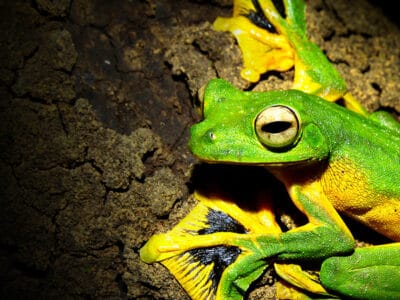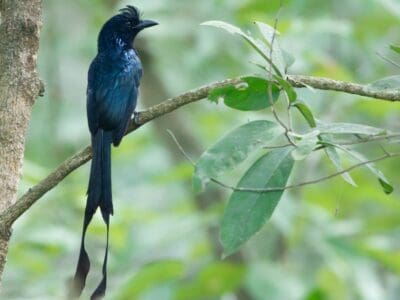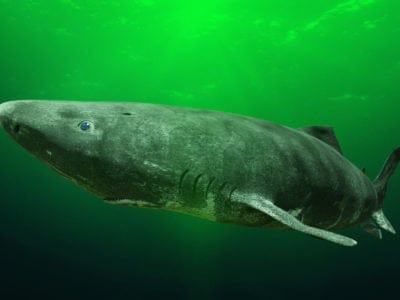The body of Wiwaxia was covered by rows of sclerites and spines
Advertisement
Wiwaxia Scientific Classification
- Kingdom
- Animalia
- Phylum
- Mollusca
- Family
- Wiwaxiidae
- Genus
- Wiwaxia
- Scientific Name
- Wiwaxia corrugata
Read our Complete Guide to Classification of Animals.
Wiwaxia Conservation Status
Wiwaxia Facts
- Prey
- Microorganisms on the ocean floor
- Fun Fact
- The body of Wiwaxia was covered by rows of sclerites and spines
- Most Distinctive Feature
- The body of the Wiwaxia was covered by rows of body armor
- Distinctive Feature
- Long spines on its back
- Habitat
- Bottom-dweller in the Cambrian sea
- Diet
- Omnivore
- Special Features
- Rows of spines on its back
- Number Of Species
- 5
Wiwaxia Physical Characteristics
- Height
- 0.04 inches
- Length
- 0.08–2 inches
- Venomous
- No
- Aggression
- Low
View all of the Wiwaxia images!
Wiwaxia was a soft-bodied marine invertebrate that lived during the Cambrian Period. Covering its soft body is protective carbonaceous scales and spines. The remains of the creature consist majorly of isolated scales that have been found in various locations around the world. There is division in the scientific community on the exact classification of this animal. While some groups classify it as a prehistoric worm based on the scales, others think it might have been a shell-less mollusk.
Description and Size

An artist creates their own rendering of Wiwaxia from the Cambrian period.
©Wiwaxia_corrugata.jpg (482 × 445 pixels, file size: 313 KB, MIME type: image/jpeg) – Original / License
Wiwaxia was a marine organism that lived about 541 to 485 million years ago. It was one of the earliest multicellular organisms that appeared during the Cambrian, shortly after the Cambrian explosion, during which many multicellular organisms appeared.
Wiwaxia was an elliptical-shaped organism with no distinct head or tail. When viewed from the front or rear, it would have had an almost rectangular shape. A fully grown Wiwaxia would have been up to two inches (five centimeters) long. However, smaller specimens have been discovered, with some as short as 0.08 inches (two millimeters). Scientists cannot tell how tall this animal was because their remains were typically found under compression.
Underneath, Wiwaxia was soft and had no spines or scales. There is not much to know about its internal organs. However, there are suggestions it had a feeding apparatus with two rows of pointy teeth.
The body of Wiwaxia had rows of sclerites (small armor plates). There were eight rows in total. The majority of the sclerites had an oval shape, but the ones closest to the sea floor had a crescent-moon shape. Rather than just superficial body covering, the sclerites were buried deep within the organism’s body. In fact, up to 40% of the length of each sclerite is within the body.
In addition to the armored plates, the Wiwaxia also had two rows of upward-pointing spines on its body. You can only see the spines on bigger specimens. This suggests that it was absent in juveniles but would appear as the organism grew.
Even though the sclerites and spines were unmineralized, they were made of a strong organic biopolymer. Experts think Wiwaxia was able to regenerate lost spines. The rows of scales and spines would have protected this organism from predators.
History and Evolution
During the Early Cambrian, when this animal evolved, most of the taxonomic groups of animals we are familiar with today were just starting to evolve. Many more lineages that appeared back in the Cambrian are now completely extinct. Some of these extinct groups show intermediate characteristics to two or more modern groups.
The Wiwaxia’s evolutionary affinities have been a subject of debate in the scientific community since its discovery. Scientists that have studied this animal propose different possibilities. On one hand, the rows of scales present on the Wiwaxia’s body is an adaptation common to certain types of scale worms (annelids). But studies to examine the evolutionary development and diversification of this organism and annelids have shown very little morphological resemblance between them.
However, an examination of the mouthparts and general morphology of this organism suggests that it may have shared a close relationship with shell-less mollusks. Scientists in support of the second theory often point to similarities between the naked ventral surface of this soft-bodied creature and the foot and radula of the mollusks.
The closest relative of this animal identified so far is the Odontogriphus omalus. This animal also had a ventral creeping foot with gills around it. Both Wiwaxia and Odontogriphus had molluscan ancestry. There’s also a possibility that the Wiwaxia belongs to a stem group completely different from any modern family.
Diet—What Did Wiwaxia Eat?
Wiwaxia was a slow-moving animal and was probably not an active hunter for prey. Rather it was a bottom-feeder. The Cambrian sea, where this organism lived, didn’t have many living organisms to feed on. However, they probably scraped bacteria and other microorganisms off the microbial mat on the prehistoric sea floor.
Paleontologists have found evidence of a feeding apparatus on the underside of their bodies. The feeding apparatus had two or three rows of backwards-pointing conical teeth. Scientists are not exactly sure of the exact nature of this feeding apparatus or how the animal used it. But it was tough enough to preserve and was fairly flexible as well.
Habitat—When and Where It Lived
Wiwaxia was a marine organism. It lived in the early to mid-Cambrian seas about 541 to 485 million years ago. At that time, the majority of life was in the water. Paleontologists have found abundant remains of Wiwaxia in the famous Burgess Shale of North America. Other notable site sites with fossils of this organism include China, Australia, and the Czech Republic.
Threats and Predators
The only known defensive mechanism Wiwaxia had were the spines and scales on its body. Its slow movement and lack of active swimming apparatus would have put it at a great disadvantage if it lived during a period when abundant predators existed in the marine ecosystem. Fortunately, life was relatively sparse in the Cambrian sea, and this organism probably didn’t have a lot of natural enemies. However, this organism lived during a period of rapid changes in the earth’s climatic conditions. With time, changes in living conditions in the Cambrian seas would have threatened the existence of this creature.
Discoveries and Fossils
Wiwaxia was first described based on fossils found in the Ogyopsis Shale deposit in 1899. The first specimen was an isolated spine which scientist G. F. Matthew named “Orthotheca corrugata.” In 1911, Charles Doolittle Walcott discovered more specimens in Burgess Shale deposits of the Canadian Rocky Mountains. He thought it was a type of annelid worm and assigned it to a new genus called Wiwaxia.
In 1966, another team of paleontologists revisited the site and came across abundant remains of the invertebrate. The recovered remains were so many that it took years to complete their analyses.
Wiwaxia was also discovered in Georgina Basin, Australia, in 1991. This was the first discovery of the organism in other deposits aside from the Burgess shale. Since then, more fossils have turned up from various locations across the globe. Some articulated and fragmentary remains have been found in China and the Buchava Formation of the Czech Republic. Other discovery sites are Emu Bay Shale in South Australia and the Sinsk Biota of Siberia.
Extinction—When Did Wiwaxia Die Out?
Wiwaxia became extinct during the mid-Cambrian period. It probably lived between 541 and 485 million years ago. No fossil records indicate the organism’s survival into the Late Cambrian. It is unclear what could have caused the organism’s disappearance, but the Wiwaxia died due to changes in the condition of the Cambrian sea where it lived. The changes in the prehistoric earth’s ocean floor would have caused a depletion in the main food source of this organism.
Similar Animals to Wiwaxia
- Hallucigenia — Hallucigenia was a bizarre creature that lived during the Cambrian. This worm-like organism is famous for its unusual appendages and spines. It moved on the Cambrian sea floor using its long, pointed legs and had long spines for defense like the Wiwaxia.
- Ottoia — This is a genus of carnivorous worms that lived in burrows on the mid-Cambrian sea floor. Paleontologists have found remains of the Ottoia in the Burgess Shale deposit as well.
- Slugs — Slugs are shell-less mollusks that belong to the class Gastropoda. Their bodies are soft, and they have no legs. It has two pairs of retractable tentacles for sensing both light and smell.
- Snails — A snail is essentially slugs with shells (shelled gastropods). The shells are often large enough for the organism to retract inside. Different species of snails live in a wide range of habitats, including freshwater, the sea, and on land.
Related Animals
View all 114 animals that start with WWiwaxia FAQs (Frequently Asked Questions)
When was Wiwaxia alive?
Wiwaxia lived during the Early to Middle Cambrian Period, about 541 to 485 million years ago.
How big was Wiwaxia?
The invertebrate was relatively small. The length of Wiwaxia ranged from 0.079 to 2 inches on average A typical specimen may have grown up to 0.39 inches high. However, the exact height is difficult to estimate because fossils are often compressed.
What did Wiwaxia look like?
The ancient organism had an elliptical body covered in spines and armor plates (except for the underside). Wiwaxia must have looked like a miniature porcupine with no well-defined head or tail.
Why is Wiwaxia important?
The animal came into existence during the Cambrian explosion (an event that occurred 541 to 530 million years ago). The abundant fossil of Wiwaxia made it possible to understand how the early metazoans lived and evolved during the Cambrian Period.
Was Wiwaxia a mollusk?
The extinct creature was a strange metazoan with characteristics of both a primitive mollusk and a polychaete annelid. Recent studies into the physiological morphology of the organism have revealed a closer association with mollusks.
Thank you for reading! Have some feedback for us? Contact the AZ Animals editorial team.
Sources
- Wikipedia / Accessed November 19, 2022
- A-Z Animals / Accessed November 19, 2022
- Prehistoric Wildlife / Accessed November 19, 2022
- Earth.com / Accessed November 19, 2022


















